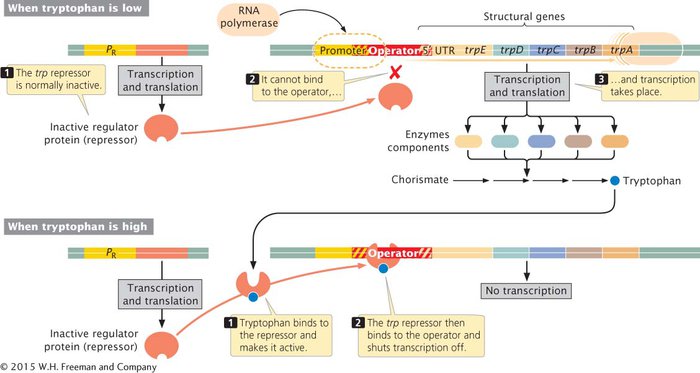The trp Operon of E. coli
The lac operon just discussed is an inducible operon, one in which transcription does not normally take place and must be turned on. Other operons are repressible; transcription in these operons is normally turned on and must be repressed. The tryptophan (trp) operon in E. coli, which controls the biosynthesis of the amino acid tryptophan, is an example of a negative repressible operon.
The trp operon contains five structural genes (trpE, trpD, trpC, trpB, and trpA) that produce the components of three enzymes (two of the enzymes consist of two polypeptide chains). These enzymes convert chorismate into tryptophan (Figure 12.13). Upstream of the structural genes is the trp promoter. When tryptophan levels are low, RNA polymerase binds to the promoter and transcribes the five structural genes into a single mRNA, which is then translated into the enzymes that convert chorismate into tryptophan.

Some distance from the trp operon is a regulator gene, trpR, which encodes a repressor that is normally inactive (see Figure 12.13). Like the lac repressor, the tryptophan repressor has two binding sites, one that binds to DNA at the operator and another that binds to tryptophan (the corepressor). Binding to tryptophan causes a conformational change in the repressor that makes it capable of binding to the operator, which overlaps the promoter. When the operator is occupied by the repressor, RNA polymerase cannot bind to the promoter, and the structural genes cannot be transcribed. Thus, when cellular levels of tryptophan are low, transcription of the trp operon takes place and more tryptophan is synthesized; when cellular levels of tryptophan are high, transcription of the trp operon is inhibited and the synthesis of more tryptophan does not take place.
CONCEPTS
The trp operon is a negative repressible operon that controls the biosynthesis of tryptophan. In a repressible operon, transcription is normally turned on and must be repressed: this is accomplished through the binding of tryptophan to the repressor, which renders the repressor active. The active repressor binds to the operator and prevents RNA polymerase from transcribing the structural genes.
 CONCEPT CHECK 6
CONCEPT CHECK 6
In the trp operon, what happens to the trp repressor in the absence of tryptophan?
It binds to the operator and represses transcription.
It cannot bind to the operator and transcription takes place.
It binds to the regulator gene and represses transcription.
It cannot bind to the regulator gene and transcription takes place.
b